10 Best Guitar Books for Beginners: Master the Basics Quickly
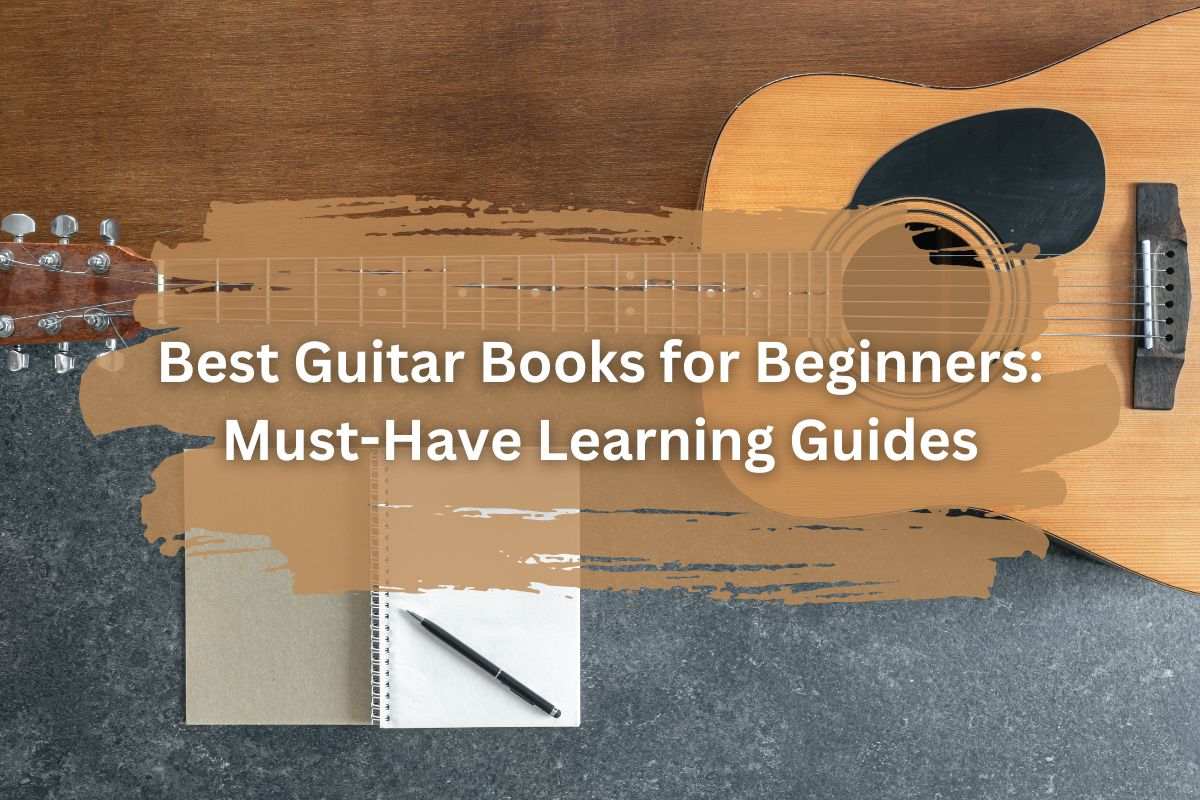
90% of new guitarists quit playing within the first year. [Research Gate, 2023]
Often the blame goes to the lack of progress.
This was coming actually. Despite having several materials, guitarists lose motivation midway. Perhaps the learning process wasn’t effective or the book wasn’t fun.
Being a beginner, you must pick a good book to learn to play guitar. This is something that works to shape the entire personality of the potential guitarist.
So how would you understand which book to pick?
Stress these factors –
- Easy to read
- Simple step-by-step instructions
- Simplifying jargons
- Proper and engaging illustrations
- Extra materials like audio and video content
We get that the market is overpopulated with lots of guitar books for beginners. Multiple options can make you go blank.
To help you out, we’ve compiled the 10 best guitar books for beginners.
Key Highlights:
- The best guitar book for beginners is— Hal Leonard’s Guitar Method.
- Combine books, video content, and audio tracks to learn efficiently.
- Each book has individual strengths to help you become a pro.
- Choose the best guitar books by considering factors like— skill level, formats, and guitar types.
- Make sure the guitar is easy to read.
- A good beginner guitar book always has proper instructions and illustrations.
Why Guitar Books Are Essential for Beginners?
- A comprehensive and structured approach
- Guiding you through the basics
- Ability to revisit lessons anytime
- Learning at your own pace
- Offline learning without distractions
What to Look for in a Guitar Book for Beginners
- Clear, concise instructions
- Easy-to-follow exercises
- Well-rounded content: theory, technique, and practice songs
Top 10 Guitar Books For Beginners [Quick Look]
| Book Title | Authors/Publishers | Best Age Group | Key Feature |
| Hal Leonard Guitar Method | Will Schmid & Greg Koch | Young Adults, Adults, Seniors | Fresh guitar lessons |
| Guitar for Dummies | Mark Phillips & Jon Chappell | Young Adults, Adults, Seniors | Fun to read with jokes and cartoons |
| Teach Yourself to Play Guitar | David M. Brewster | Young Adults and Adults | Self-learning with tablature |
| The Guitar Handbook | Ralph Denyer | Young Adults and Adults | Extensive guide |
| Guitar Aerobics | Troy Nelson | Young Adults and Adults | Daily exercise on building technical skills |
| First 50 Songs You Should Play on Acoustic Guitar | Hal Leonard Corp | Young Adults, Adults, Seniors | Compilation of pop songs |
| Progressive Guitar Method for Young Beginners | Gary Turner | Kids and Young Adults | All basics are compiled with colorful pictures and simple instructions |
| The Complete Guitar Manual | Dorling Kindersley | Young Adults and Adults | Rich and detailed illustrations |
| Mel Bay’s Modern Guitar Method | Mel Bay | Adults and Seniors | Effective structure and well-organized |
| You Can Teach Yourself Guitar | Mel Bay | Adults and Seniors | Easy and well-organized instructions |
Top 10 Best Guitar Books for Beginners
#1 “Hal Leonard Guitar Method” by Will Schmid & Greg Koch
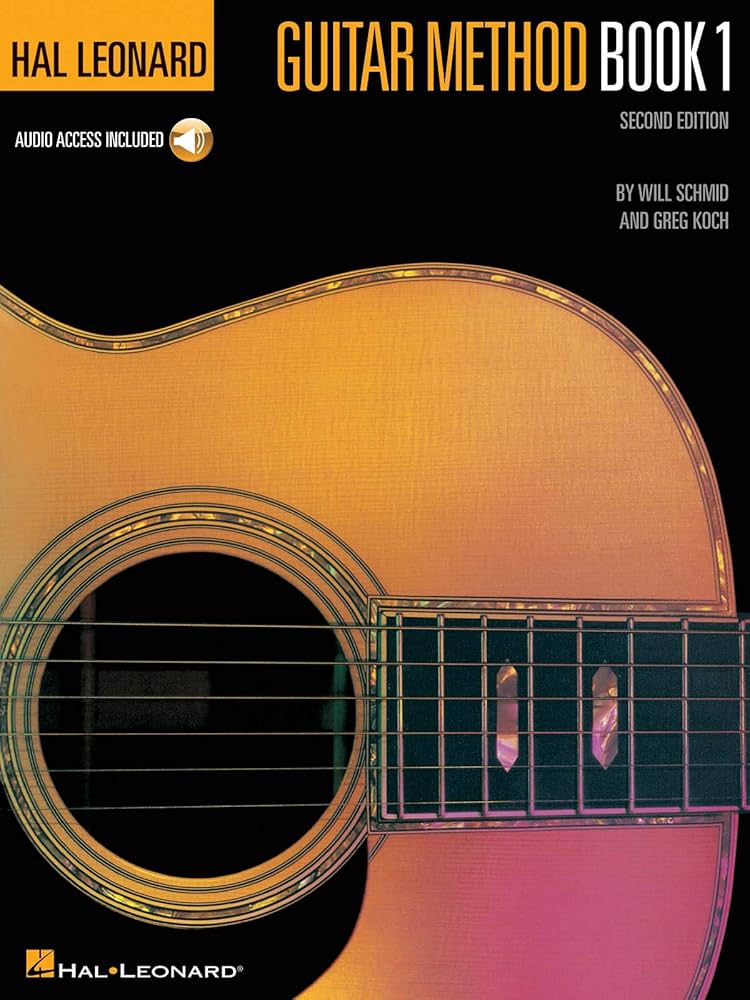
Comes with fresh lessons.
Gen Z would love this book for its new examples and modern approach. It covers a wide range of contemporary genres with a bit of traditional. You get a variety of songs to learn from— rock, blues, jazz, country music, and folk.
Here’s an interesting part. The guitar book takes a break after teaching you notes on the first four strings so you don’t get bored.
To amp you up, there are different lessons on playing chords. After some pages, it goes back to note lessons on the fifth and sixth strings.
“Hal Leonard Guitar Method” compiles years of experience helping students of all ages learn to play guitar. It has some of the best teaching ideas from different parts worldwide.
All the lessons are both simple and fun to learn. Its step-by-step lessons seem easy which makes it great for beginners. Even if reading seems tiresome, it has an audio version.
Why It’s Great for Beginners?
- Step-by-step lessons.
- Covers a wide range of genres.
- Includes both chords and melodies.
Key Elements
- Comprehensive learning guide with online access to audio.
- New examples and guitar lessons.
#2 “Guitar for Dummies” by Mark Phillips and Jon Chappell
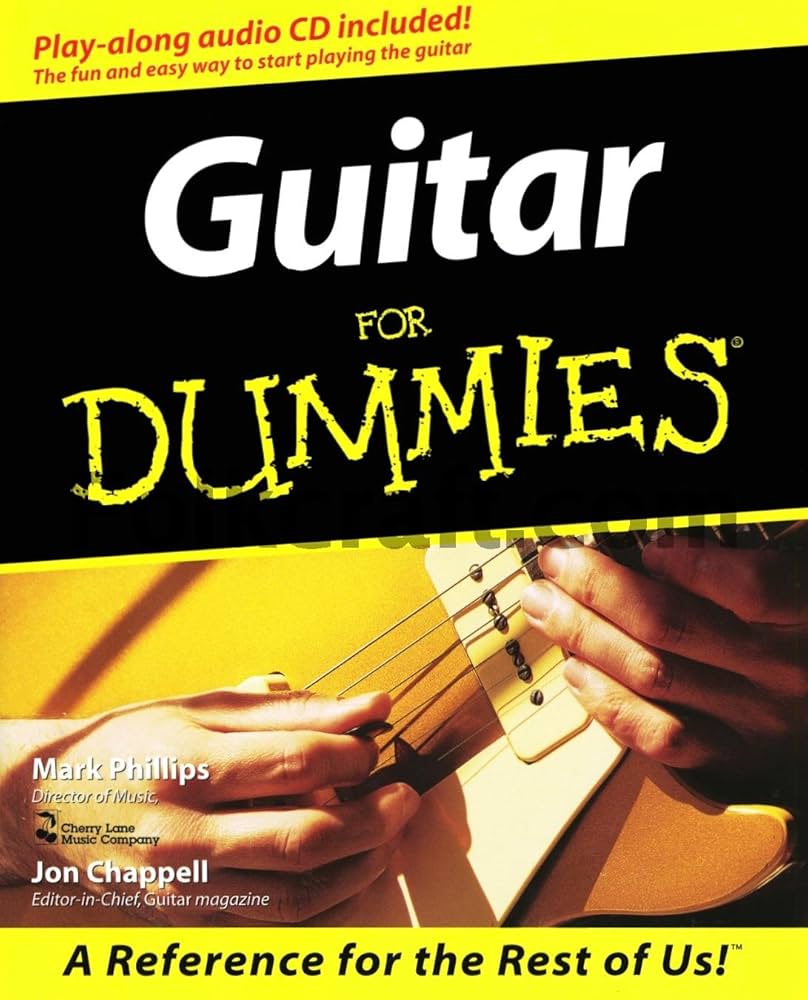
Fun and approachable tone.
“Guitar for Dummies” takes the cake with little quips and jokes now and then. The cherry on top is— the funny cartoons and illustrations that make sure to catch your attention.
It does a great job of breaking down and simplifying jargon and chords with ease. Its conversational tone even makes you feel like the teacher is right there.
The book portrays songs in musical notation and guitar tabs that make it easier.
With the latest edition, you get introduced to different genres of guitar playing— from blues and rock to folk and jazz. Besides popular music, it emphasizes the guitar fretboard to teach you music theory for the guitar.
The book is full of practical advice and tips on common beginner mistakes to avoid. This makes learning less intimidating for beginners and saves them a lot of frustration.
You’ll even get a CD with this guitar book. That way, you can explore the audio tracks and follow along with real sound examples.
Why It’s Great for Beginners?
- Easy-to-understand language.
- Friendly tone and layout.
- Offers practical advice and tips.
Key Elements
- Fun and accessible style.
- Online audio tracks included.
#3 “Teach Yourself to Play Guitar” by David M. Brewster
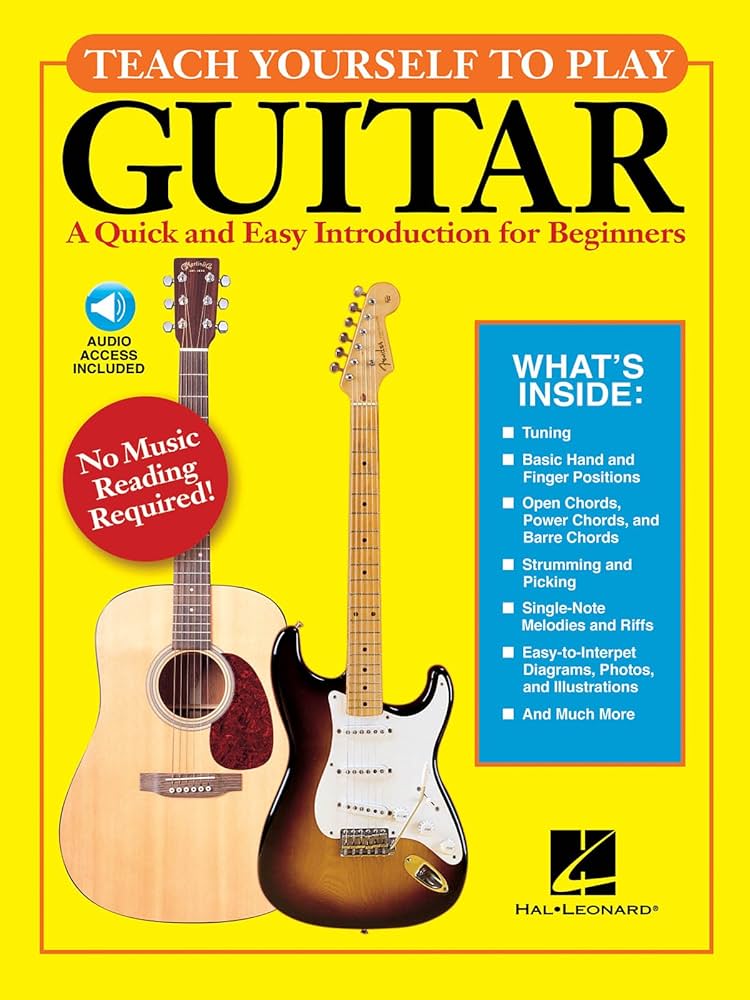
Self-instructional guide with tabs.
This one tries out a different approach. Instead of musical notes and symbols, the guitar book uses ordinary characters and numbers. These are what you call tabs. In short, it teaches you to play through such a format.
Tablature gives you a visual representation of the strings. It’s like a way of writing down music to play on guitar. Such a form is one of the most effective and easiest ways to learn guitar.
Because— it visually simplifies finger placement and strumming patterns.
The book also covers instructions on barre chords, power chords, single-note patterns, and fills. This can easily help you learn the pattern and hand positioning for the guitar.
You can learn to play different music styles from this one. For instance— rock, folk, classical, country, and more. There will be some good pictures with descriptions to help you get started.
Each of the lessons is well-organized. All the exercises are quite practical. So you’re learning what you’ll actually use.
Why It’s Great for Beginners?
- Ideal for self-learners.
- Simple, straightforward lessons.
- Focuses on essential skills.
Key Elements
- Includes practical exercises.
- Uses tablature for easy learning.
If you’re looking for the best online guitar lessons, here’s a relatable read.
#4 “The Guitar Handbook” by Ralph Denyer
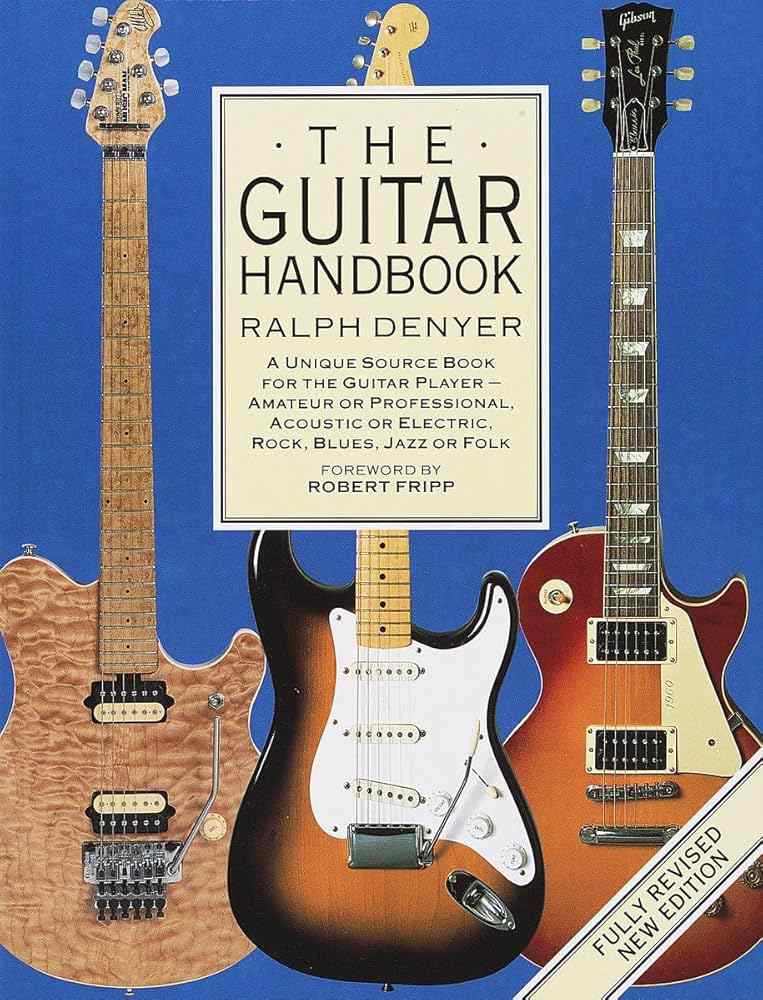
Unique treasure with all the details.
The Guitar Handbook builds a strong foundational knowledge of almost everything related to the guitar. It includes— history, how to play the instrument, how to maintain it, and ways to customize it.
That’s not it. Ralph Denyer has added a chord dictionary. There you get over 800 easy-to-follow fingerings and concise text. This helps you expand your skills without complicating information.
Plus, the book has lots of information packed into very digestible sections. One section details the performance, hardware, special effects, tech, and recording facilities. Since it makes intricate topics more approachable, you can easily learn at your own pace.
It also explains some music theory concepts that help you become a pro. From simple chords to advanced improvisations, you get all compiled in this treasure.
This shows how comprehensive the guide is.
The best part is— the plenty of graphics, step-by-step photographs, and diagrams that make things clearer. All colorful!
Why It’s Great for Beginners?
- In-depth coverage of both theory and technique.
- Suitable for beginners and intermediates.
Key Elements
- Combines technique, history, and practical lessons.
- Colorful illustrations.
#5 “Guitar Aerobics” by Troy Nelson
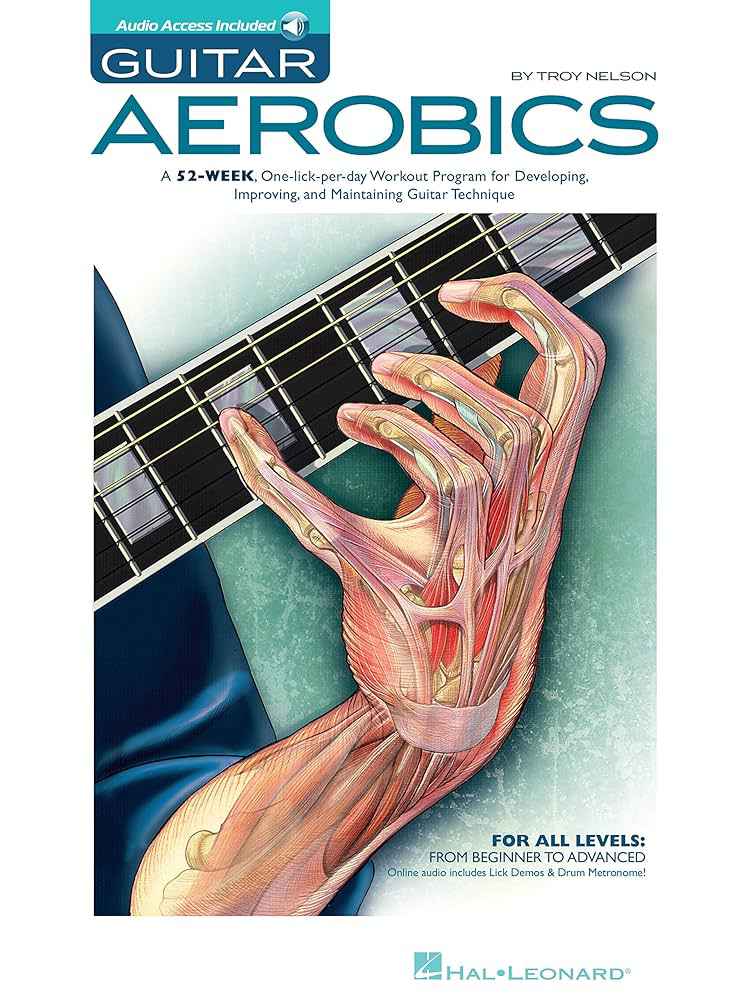
A vigorous blend of exercises.
Guitar Aerobics intrigues you with its creative way of guitar learning. The standout feature is its focus on daily practice. It has a series of exercises that you follow every day.
You kick-start at a slow tempo to get comfy with the instrument. Then, build up your skills. Each exercise has about 8 sets of 10 repetitions. By the time the exercise is done, it’s pretty well internalized.
The program focuses on various skills like— arpeggios, bending, alternate picking, and sweeping on different days. Every week, the exercises get a bit harder to fine-tune your expertise.
In short, this beginner guitar book is more about building technical skills than learning songs. It can be a helpful resource for those who want to get serious about their practice routines.
All the activities are clear and effective. They can tone your technique and fuel your creativity! You just need to stick to your daily plan.
Why It’s Great for Beginners?
- Great for building daily practice habits.
- Focuses on technique building.
Key Elements
- Focus on fine-tuning coordination, speed, and accuracy.
- One exercise for each day.
#6 “First 50 Songs You Should Play on Acoustic Guitar” by Hal Leonard Corp
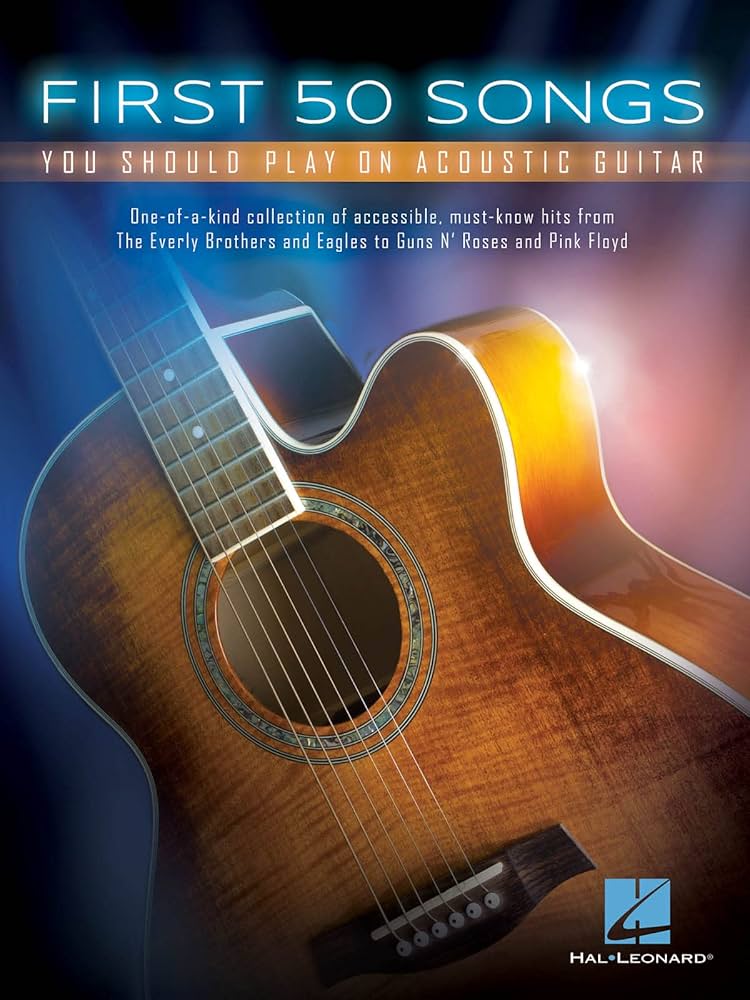
A quality compilation of multiple pop songs!
Being new to guitar always means you’re on the lookout for some good songs to strum. That’s where the book comes into play. It has lessons on 50 recognizable acoustic songs.
The songs range from classic rock and folk to pop and country. So, there’s something for everyone.
From this treasure, you can easily play awesome tracks like— Against the Wind, Boulevard of Broken Dreams, Champagne Supernova, Stairway to Heaven, and Yellow.
Fortunately, the author has oversimplified each of them. So, it won’t take time to get the hang of it. This even makes learning more fun!
The best part! You don’t need to be an expert in music theory. It explains the lessons with simple chord charts and melody lines.
Because of the variety of songs, you’ll find this guitar book more interesting. Some songs can be slightly challenging. Then again, this is where the beginners can consider polishing their art.
Why It’s Great for Beginners?
- Easy-to-learn popular songs.
- Suitable for beginners wanting to play songs quickly.
Key Elements
- Chord and melody arrangements.
- Focuses on acoustic guitar songs.
Relatable read: Different Types Of Acoustic Guitars Explained And Recommended.
#7 “Progressive Guitar Method for Young Beginners” by Gary Turner
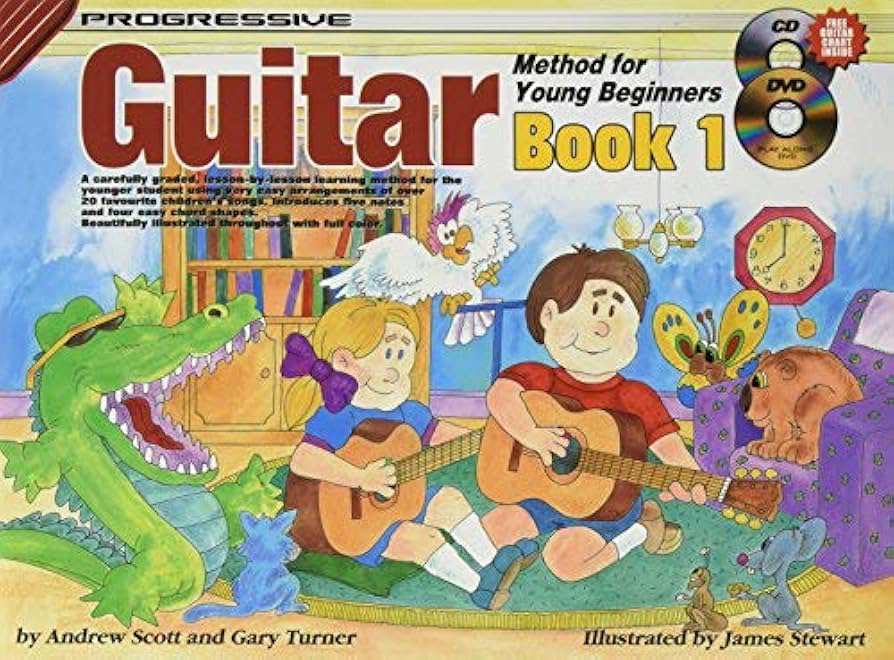
An electrifying adventure for the littles.
This one is particularly for the kids. It has all the essentials combined like— holding the guitar, strumming, and reading music. There are some easy exercises that they can have fun with.
One big benefit is the colorful illustrations and simple instructions the pages carry. It makes learning guitar more exciting for them.
The guitar book begins with note reading instead of chords. Such an approach is less confusing. Why? Because it lets them focus on playing one note at a time so they can build their skills gradually.
This way, the kids get a strong base in music before moving on to complex chords.
Moreover, it has easy lessons to teach the basics of– melody, pitch, and timing. It also includes popular children’s songs. So, the book knows how to keep young learners hooked.
It can be a great resource for parents or teachers who wish to introduce littles to the world of guitar.
Why It’s Great for Young Learners?
- Perfect for children learning guitar.
- Includes engaging exercises and illustrations.
Key Elements
- Simple melodies and easy exercises.
- Well-paced for younger players.
#8 “The Complete Guitar Manual” by DK
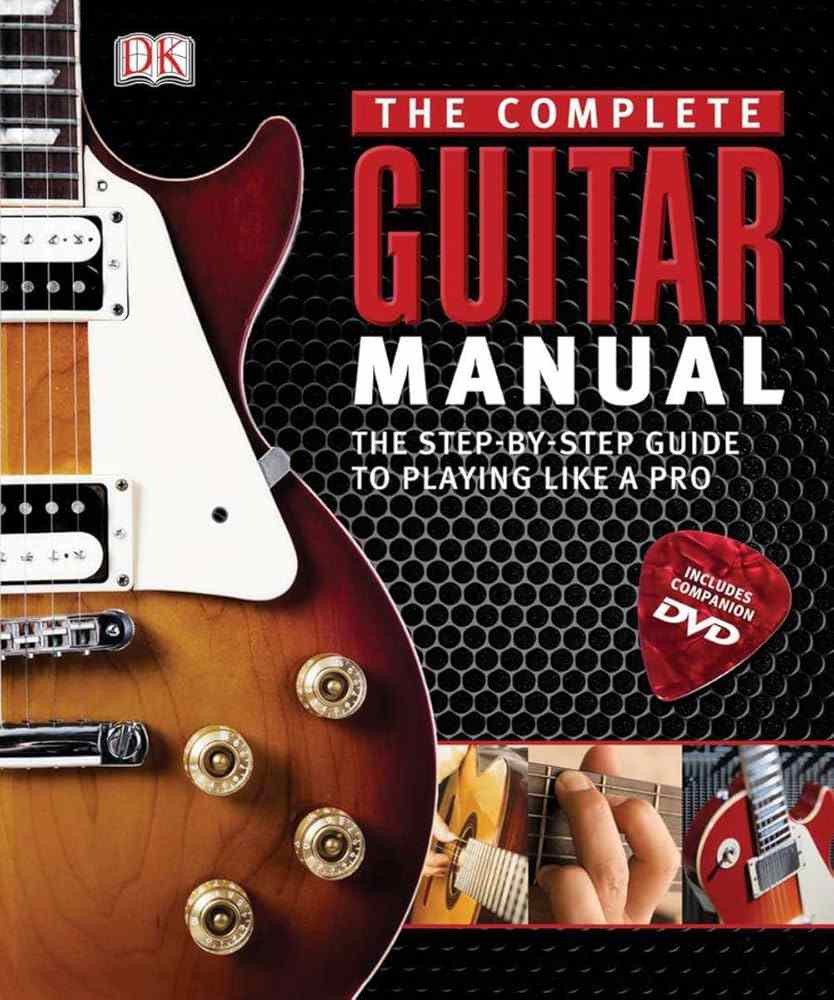
Strikes you with all the vibrant illustrations.
This guitar book boasts clear, detailed photos besides step-by-step instructions. The graphics and prints are rich and of high quality. This takes the teaching game to the next level.
Now the lessons. There will be lots of information but all have been covered in a simpler tone. It has almost everything— from choosing the first guitar and basic techniques to reading tabs and using amps or effects. All of these are only to help sharpen your skills.
You can learn to play both acoustic and electric guitar from this one. No matter whether you’re strumming a classic or rocking out, the book has lessons for different music genres. The cherry on top is the bonus tips and techniques on them.
Plus, it has insights into gear setup and maintenance. It can help you get the most out of your instrument.
The instructions are easy to read and the chapters are all well-organized.
Why It’s Great for Beginners?
- Visually rich guide with plenty of photos and diagrams.
- Covers both acoustic and electric guitar.
Key Elements
- Step-by-step lessons.
- Clear diagrams for visual learners.
#9 “Mel Bay’s Modern Guitar Method” by Mel Bay
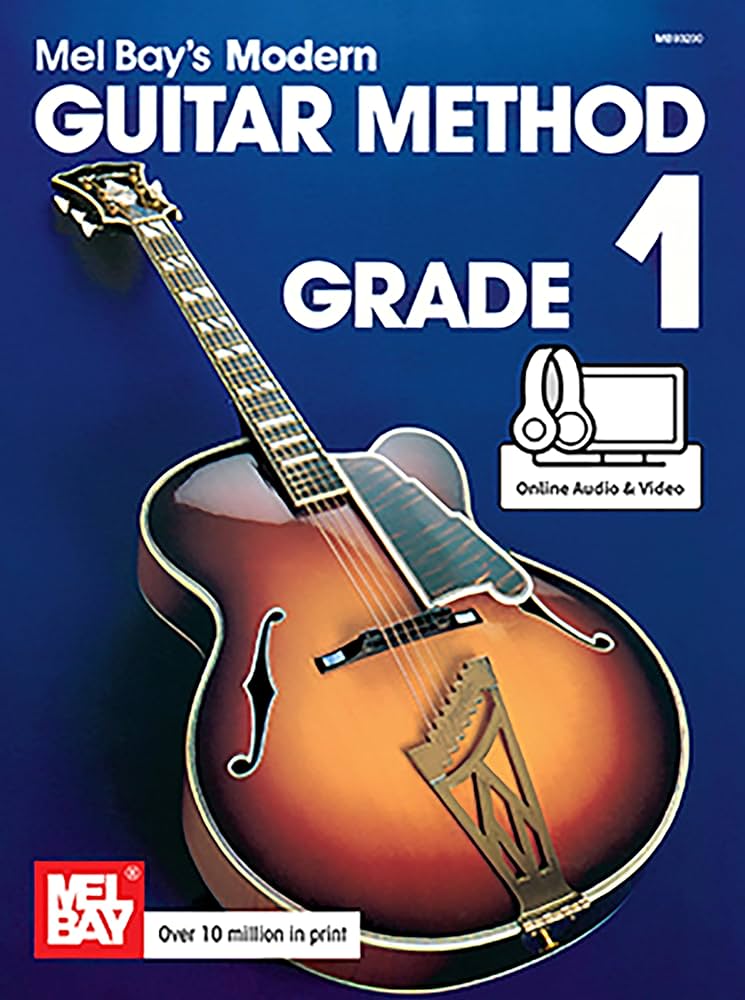
A go-to guitar book for young and mature beginners.
Regardless of whether you’ve just started or want to upgrade, the book has lessons for all skill levels.
Its structure is the best part. Just take a look and gaze at how well-organized it is. This makes it much easier to learn and play guitar.
Each lesson builds on the previous one and the difficulty level increases gradually. So, the writer has made sure you don’t feel overwhelmed.
The Modern Guitar Method details almost everything. There’s a lesson on the basic chords and music theory. Plus, it lets you explore different styles like— rock, pop, and classical.
You’ll also find lots of exercises. They can help strengthen your fingers and polish your technique.
The book focuses on note-reading too. You can easily get music better.
Why It’s Great for Beginners?
- A traditional approach to learning guitar.
- Focus on reading standard notation.
Key Elements
- Includes thorough exercises for mastering technique.
- Suitable for those looking to read music.
Don’t know how to read guitar sheet music? Here’s a relatable blog.
#10 “You Can Teach Yourself Guitar” by Mel Bay
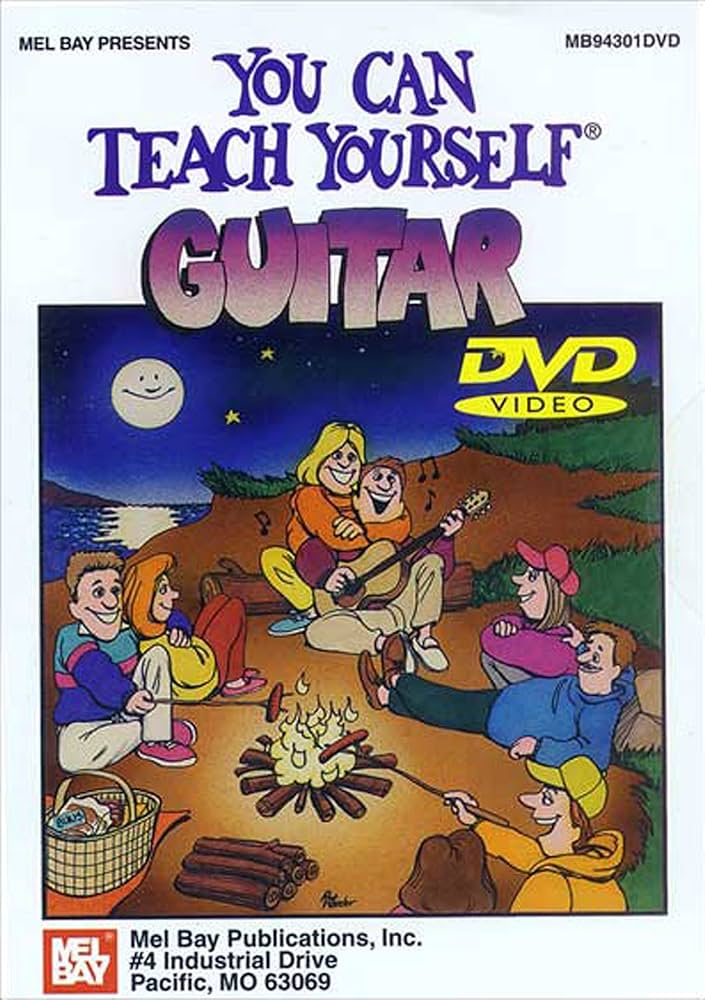
Self-learning again but it’s way simpler.
The book starts with the basics. For instance– how to hold the guitar and read music. Then it gradually moves on to chords and simple songs.
The lessons are super simple to read and well-structured. So, there’s no chance of feeling clueless.
You’ll get multiple exercises and tips. All of them are there to make your skills sharper.
The book also has a variety of songs to practice. You can play them with ease and impress your people.
One benefit is its interactive style. This makes learning more fun!
Why It’s Great for Beginners?
- Designed for self-teaching.
- Covers all the basic skills for beginners.
Key Elements
- Easy-to-follow lessons.
- Includes chord charts and strumming patterns.
How to Choose the Right Guitar Book for Your Learning Style?
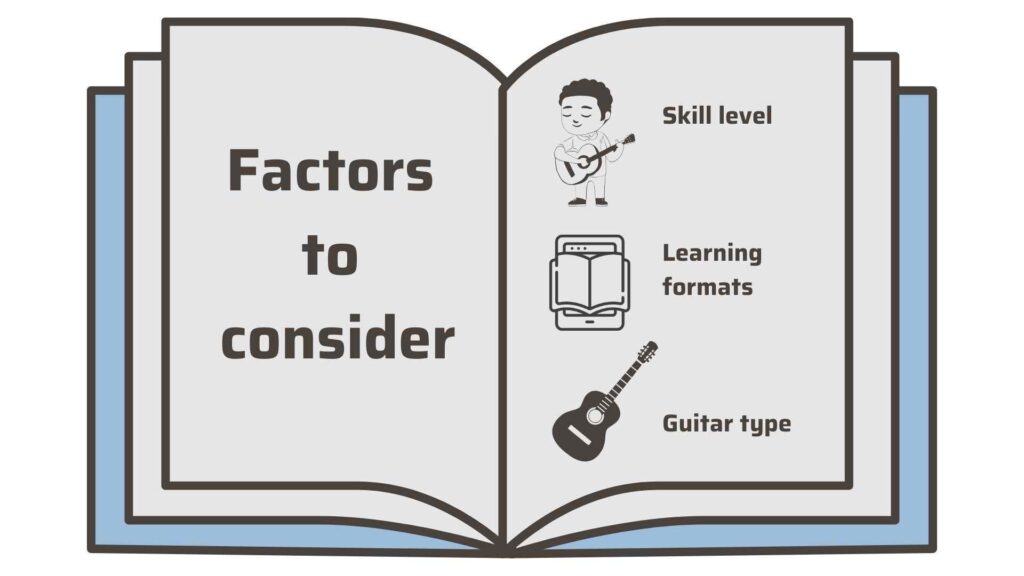
Consider Your Skill Level
The guitar book must match your skill level. This ensures—
- Effective learning
- Gradual progression
- Better understanding
Beginners
You should grab books that talk about the basics. This can be— simple chords and strumming patterns.
Such books also include easy lessons on playing simple songs and music genres.
They mostly have step-by-step instructions. And they must have it. This guidance helps you build a solid foundation.
Intermediate players
You can dive deeper into technique and theory. If you’ve mastered the basics, opt for books that cover more advanced topics.
For instance— fingerpicking, music theory, and specific genres. They’ll help you explore new styles and sharpen your skills.
Learning Formats (Traditional vs. Modern)
Guitar books come in both printed and digital forms.
No matter what! Pick the one that’s easier to read. Being a beginner, you might struggle with jargon, theories, and techniques. So, go through some feedback to see if the books have made it simple for you.
- Printed Guitar Books
They have one big advantage– focus. You can stay focused while reading the book. There won’t be any distractions from your device that can interrupt.
Moreover, with physical editions, you can highlight parts, mark pages, jot down in the margins, and easily flip through the pages as you practice strumming.
The issue is they can be a bit pricy.
- Digital Guitar Books
They give you convenience. You can read the lessons on your phone, tablet, kindle, or computer. Plus, you can wander around and take them anywhere.
Many of them also have cool features. They help you see and hear how to play the guitar.
For instance, interactive tabs and links to video lessons.
One drawback is that it can distract you. Because you’ll be accessing the book from devices.
However, no matter what you pick! Try to get books that have audio or video content.
Such extras are super helpful, especially for beginners.
Watching someone show you a technique and hearing how chords should sound— all these make things clearer.
One study mentions that people only remember:
“10% of what they read — — 20% of what they hear — — 30% of what they see — — 50% of what they see and hear.”
So, a combination of all helps you more effectively in the guitar learning process.
Types of Guitars Covered (Acoustic vs. Electric)
Pick a book that goes well with the guitar type you’re learning. For example—
- Acoustic Guitar Books
The pages have all the details focusing on how acoustic works. Such guitars have hollow bodies. They produce sound naturally without an amplifier. So, the technique will be different and unique.
The books mainly cover—
- Understanding guitar parts– neck, head, and body.
- Methods to hold.
- Basic strumming and chords.
- Fingerpicking techniques.
- Simple songs that sound great on acoustic.
Acoustics are great for genres like folk, country, or classical. If you want to master them, go with an acoustic guitar book.
- Electric Guitar Books
Behind the cover, you get words talking about the profile of electric guitars. Such guitars need an amp to produce sound. So, the approach will vary.
The books cover—
- Introduction to parts like– pickups and controls.
- Music notation and TAB.
- Techniques like bending notes.
- Ways to use effects pedals.
- Solo styles.
Electric guitars are suitable for genres like metal and rock. Consider them if you want to learn such music.
2 Bonus Tips for Beginner Guitarists
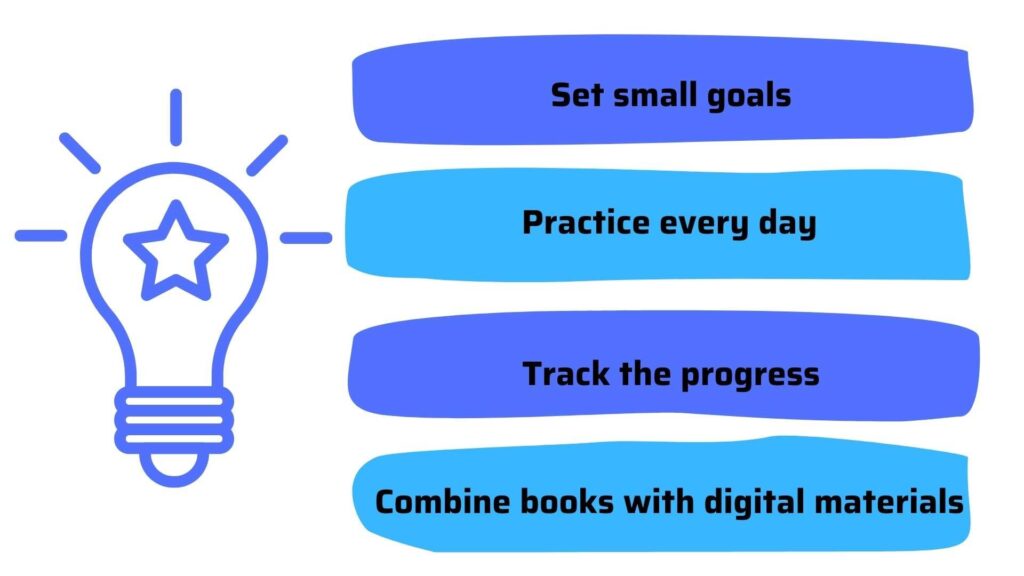
- Setting Realistic Goals
When learning guitar– don’t rush or hurry. Instead, set small, realistic goals.
You don’t have to stress yourself out and be involved in longer sessions. We suggest that you practice a little every day. Use your guitar book to track the progress.
Also do these—
- Highlight essential parts.
- Mark the exercise you completed.
- Repeat them.
- Use a practice log.
- Fix a goal that you want to achieve next.
- Record yourself.
Even small milestones count!
- Complementing Books with Other Learning Resources
Combine books with online tutorials and YouTube lessons.
You can try tutorials and tips Zager has shared in his video content.
Such content can show you how to play techniques in real-time. Moreover, join guitar communities online or in person. Getting feedback from others can help you stay motivated and improve your skills.
Frequently Asked Questions
No. You need a combination of guitar books, visual tutorials, and audio tracks to learn guitar more effectively.
Multiple authors have covered guitar books for children. Some are—
• Progressive Guitar Method for Young Beginners
• Guitar for Kids: Hal Leonard Guitar Method
• Children’s Guitar Method Volume 1 William Bay
Such guitar books for kids have fun illustrations and exercises that make learning process interesting.
You don’t have to.
Many beginner guitar books use tablature (tabs) that make it easier for you to learn guitar. So, you don’t need to know music theory. Books like Teach Yourself to Play Guitar are one of them.
Zager recommends practicing at least 30 minutes each day to learn to play guitar.
You can break it down into smaller sessions like 15 minutes twice a day.
No. Stick to one guitar book. Having multiple books can end up confusing you.
However, you can try different books if you want to move on to advanced skills from basics.
Be A Pro Like Zager With The Best Guitar Book
All the guitar books have something unique to offer. For instance–
- Structured lessons
- Great illustrations
- Fun exercises
- A deep dive into the theory
It’s picking the right guitar book that can make a big difference.
Make sure you consider factors like expertise level, learning formats, and guitar types. These will help you grab the apt one.
Although we’ve added the top 10 options, the best depends on the book that matches your requirements.
However, one thing is sure.
